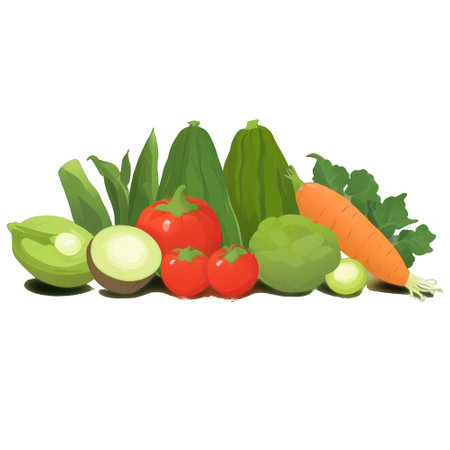Introduction to Sowing Times in the UK
If you have ever tried your hand at growing vegetables here in the UK, you’ll know there’s a certain rhythm to it all – a dance with the seasons, if you will. Our temperate climate, marked by unpredictable frosts and cool springs, means timing is everything when it comes to sowing seeds both indoors and outdoors. Plant too early, and you risk losing tender seedlings to late cold snaps; leave it too late, and you might miss out on a full harvest before autumn’s chill sets in. Understanding the key dates for starting your vegetables is not just a matter of convenience – it’s the very foundation of a successful allotment or garden patch. Whether you’re nurturing tomato seeds on a sunny windowsill or waiting for the soil to warm up enough for carrots outside, knowing when to start makes all the difference. In this guide, we’ll walk through the importance of choosing the right moment, shaped by decades of gardening wisdom and the unique quirks of our British weather. This way, you can make the most of every growing season, giving your veg the best possible start and yourself a rewarding harvest come summer and autumn.
2. Understanding the UK Vegetable Growing Seasons
When it comes to growing vegetables in the UK, timing is everything. The British climate can be unpredictable at the best of times, so having a good grasp of the growing calendar is vital for success, whether you’re sowing seeds indoors or planting out in the garden. The main factor that determines your sowing and planting dates is the last frost, which varies considerably across the country. For most regions, this falls somewhere between late March and mid-May.
The Typical UK Growing Calendar
| Region | Approximate Last Frost Date |
|---|---|
| South West England | Late March – Early April |
| South East England | Early – Mid April |
| Midlands | Mid – Late April |
| Northern England | Late April – Early May |
| Scotland & Northern Ireland | Mid – Late May |
This general guide gives you an idea of when it’s safe to move tender young plants outdoors or direct-sow seeds into open ground. However, do keep in mind that local microclimates—such as sheltered city gardens or exposed rural plots—can push these dates forward or back by a week or two.
Regional Climate Considerations
The UK’s weather is famously changeable, but certain trends persist. Southern parts enjoy milder winters and earlier springs, allowing for an earlier start to the growing season. In contrast, gardeners in Scotland and Northern Ireland often have to wait until late May before they can safely plant out frost-sensitive crops like tomatoes and courgettes. If you’re gardening in a particularly chilly spot, consider using cloches or fleece to protect early sowings.
A Practical Tip from Experience
If you’re ever unsure about your local last frost date, chat with neighbours or visit your nearest allotment site—there’s nothing quite like local knowledge passed down through generations to guide your planting decisions. By aligning your vegetable sowing with the rhythms of the British seasons, you’ll give your crops the best possible start.

3. Key Dates for Starting Vegetables Indoors
When it comes to getting a head start on your vegetable garden in the UK, sowing seeds indoors can make all the difference, especially with our unpredictable weather. Certain vegetables truly benefit from being started off inside, giving them protection from late frosts and a chance to develop strong roots before facing the elements outdoors. Broadly speaking, February through April is prime time for indoor sowing, but let’s break it down further for some common favourites.
Tomatoes
For tomatoes, you’ll want to get them going indoors around late February to early March in southern parts of the UK, and early March to mid-March if you’re further north. This gives them ample time to grow sturdy before they’re transplanted outside after the risk of frost has passed—usually late May or early June.
Peppers and Aubergines (Eggplants)
Pepper and aubergine seeds should be sown indoors from mid-February to early March. These heat-loving plants need a long growing season, so don’t delay their start. Keep them warm and well-lit on a sunny windowsill or under grow lights.
Cucumbers
Cucumbers can be sown indoors from mid-March to April. They’re quick growers once they sprout but sensitive to cold, so only move them outside when nights are reliably mild.
Other Early Starters
Leeks, celery, celeriac, and brassicas like cabbage and cauliflower also appreciate an early indoor start. Aim for late February to March for leeks and celery; brassicas can be started from March onwards.
Handy Tip
If you’re short on space or natural light indoors, try starting just a few seeds of each type and stagger your sowings every couple of weeks. This way, you’ll have healthy young plants ready for planting out as soon as the weather allows.
Remember: always check your seed packets for specific guidance—some varieties have their own quirks. But with these timelines in mind, you’ll be well placed to kick off your veg patch with confidence, whatever the British spring throws at us!
4. Key Dates for Direct Sowing Outdoors
Once the last frosts have passed and the soil begins to warm, its time to think about sowing vegetable seeds directly into your allotment or garden beds. Timing is everything here in the UK, as our unpredictable spring weather can make or break a crop. Sowing too early risks losing seedlings to cold snaps, while sowing too late can result in a poor harvest. Below is a handy table highlighting some of the most popular vegetables and their recommended direct sowing windows for British gardens:
| Vegetable | Direct Sowing Window | Notes |
|---|---|---|
| Carrots | March – June | Sow thinly; cover with fleece if cold nights threaten |
| Beetroot | April – July | Best results from successive sowings every few weeks |
| Peas | March – June | Sow in well-drained soil; protect from pigeons and mice |
| Radishes | March – August | Mature quickly; ideal for filling gaps between slower crops |
| Runner Beans | Late May – Early July | Sow after all risk of frost has passed; provide support structures early on |
| Lettuce | March – September | Sow little and often for a continuous supply; prefers cooler weather |
| Parsnips | February – April | Sow early as they need a long growing season; germination can be slow so patience is key! |
| Spinach | March – May & August – September | Avoid hot summer months as plants may bolt; keep well-watered during dry spells |
| French Beans (Dwarf) | May – July | Sow after last frost; enjoys warm, sheltered positions |
| Turnips | March – August | Mature quickly for early crops; later sowings store well into autumn and winter |
Keep an eye on your local weather forecast—up north or in exposed locations, you might want to wait an extra week or two before sowing tender crops like beans. If youre unsure, touch the soil: it should feel slightly warm to the back of your hand before you start planting. Remember, a good old-fashioned cloche or a bit of horticultural fleece goes a long way towards protecting young seedlings from chilly nights. With a bit of patience and attention to timing, youll be rewarded with healthy, thriving veg straight from your own patch.
5. Tips from Experienced UK Gardeners
If you ask any seasoned British gardener about starting vegetables, you’ll soon realise that it’s as much about wisdom passed down the generations as it is about following a calendar. Here are some pearls of practical advice and traditional know-how to help you get the best from your veg plot, no matter if you’re sowing indoors or out.
Watch the Weather, Not Just the Calendar
While key dates are handy, old hands will tell you that the British weather often has the final say. A cold snap in late April can undo early enthusiasm. Keep an eye on the long-range forecast before moving seedlings outdoors, and don’t be afraid to hold off if a frost is predicted—even if the calendar says go.
The Value of Hardening Off
Many successful growers swear by hardening off young plants. Gradually introduce your seedlings to outdoor conditions over a week or so. Start with a few hours outside during the day, increasing their exposure bit by bit—this toughens them up and reduces shock when they’re finally planted out.
Use What You Have: Recycled Containers
It’s common in UK allotments and gardens to see old yoghurt pots, loo rolls, and even egg boxes pressed into service for seed sowing. These recycled containers work well for starting seeds indoors—just remember to poke a drainage hole in the bottom!
Don’t Rush with Tender Crops
Crops like tomatoes, courgettes, and runner beans dislike chilly soil. The old saying goes “Plant beans when you can sit comfortably on the soil with your bare backside”—meaning wait until it’s truly warm! This usually means late May or early June for many parts of the UK.
Sow Successionally
To keep your kitchen supplied throughout the summer, take a tip from experienced growers and sow little and often. Rather than planting all your carrots or lettuce at once, sow a row every few weeks; this way, you avoid gluts and shortages.
Mulch and Water Wisely
UK summers may be unpredictable, but keeping young plants mulched helps conserve moisture and suppress weeds. Water in the evening or early morning to reduce evaporation—another time-tested piece of advice you’ll hear at any local gardening club.
By blending these traditional hints with awareness of key dates, you’ll give your vegetable starts every chance of thriving—whatever this year’s British weather has in store!
6. Adapting to Local Conditions and Climate Change
Growing vegetables in the UK isn’t just about following a calendar – it’s about understanding the unique microclimate of your own patch. Our weather can be as unpredictable as a British summer barbecue, so learning to read your local conditions is just as important as knowing your key sowing dates.
How to Read Your Local Microclimate
Every garden has its own quirks. Some spots catch early morning sun, while others linger in shade or suffer from cold winds. Observe which parts of your garden warm up quickest in spring, where frost lingers longest, and how the wind moves through your space. Keep an eye out for sheltered corners perfect for tender crops, or damp patches better suited for moisture-loving veg like spinach or chard.
Adjusting Timings to Suit Your Area
Seed packet instructions are a helpful guide, but don’t be afraid to tweak them. If you’re gardening in Scotland or northern England, your growing season may start later than those in the South East. Conversely, urban gardens often warm up faster than rural plots. Use tools like a soil thermometer – when your soil consistently reads 7°C or above, it’s safe to sow many hardy crops outdoors.
Dealing with Unpredictable Weather Patterns
The British climate has always kept us on our toes, and with climate change bringing more erratic weather, flexibility is key. Be prepared to cover young plants with cloches or fleece during late frosts, and provide extra shade or water in unexpected heatwaves. Keep some seeds back for successional sowing, so if one batch fails due to bad weather, you can try again a few weeks later.
Listen to local wisdom too – chat with neighbours or fellow allotmenteers to learn what works well in your area and which crops struggle. By tuning into your microclimate and adapting to the changing weather, you’ll give yourself the best chance of enjoying a productive veg patch year after year.
7. Summary and Useful Resources
If you’ve made it this far, well done! Gardening in the UK is a rewarding journey shaped by our unique climate and ever-changing seasons. To quickly recap: timing is key when starting vegetables indoors or outdoors. Most crops thrive when sown at just the right moment—too early or too late, and you may miss that sweet spot for healthy growth and strong yields.
Recap of Key Points
- Always check your local last frost date before sowing outdoors.
- Start tender plants like tomatoes and peppers indoors from late February to March.
- Hardier crops such as broad beans, onions, and early peas can be started under cover in late winter or directly outdoors from March onwards.
- Keep an eye on the weather; even with the best-laid plans, a cold snap can catch you out!
Useful Tools for UK Gardeners
- RHS Gardening Calendar: The Royal Horticultural Society offers a month-by-month guide tailored for British gardeners. It’s perfect for checking what to sow, plant, or harvest each month.
- Garden Planner Apps: Tools like the BBC Gardener’s World app or Thompson & Morgan’s planner help track sowing dates and reminders based on your postcode.
- Seed Packets: Don’t overlook these—they’re packed with advice specific to the UK climate and provide sowing windows for each vegetable variety.
Further Reading
- The RHS website (rhs.org.uk) features detailed advice for every major crop grown in Britain.
- Gardener’s World Magazine and their online resources (gardenersworld.com) offer tried-and-tested tips from experienced UK growers.
- Your local allotment society often has newsletters, bulletins, and noticeboards sharing wisdom from seasoned local gardeners who know your region’s quirks best.
A Final Word from Experience
There’s no substitute for keeping a simple gardening diary—jot down what you sowed, when, and how it fared. Over time, you’ll build up your own calendar fine-tuned to your patch of British soil. And remember: patience is part of the joy. Happy growing!


